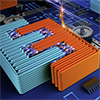| Sep 29, 2022 |
|
|
|
(Nanowerk News) Combining 3D printing technology with renewable materials and high temperature technology, a multidisciplinary project at Åbo Akademi University sets out to develop unique new-generation batteries that are both environmentally friendly and based on sodium instead of lithium.
|
|
The increasing use of renewable energy as well as the electrification of our society create an enormous need for batteries for electrical energy storage. New battery concepts are necessary to avoid depletion of the mineral resources on Earth.
|
|
Batteries consist of two electrodes: a positively charged cathode and a negatively charged anode. Between them is an electrolyte, usually a salt-containing liquid. The SUSTEC project of Åbo Akademi University intends to develop sustainable batteries by utilising 3D printing technology. The plan is to replace lithium in the cathode with sodium and the graphite in the anode with a wood-based carbonaceous material. Furthermore, the aim is to create a solid electrolyte to which the electrodes are integrated.
|
|
There is plenty of sodium in nature, for example in sea water, whereas lithium and the various forms of graphite are limited resources that need to be extracted by mining. Graphite is not the optimal choice to be used with sodium, which is why the researchers want to find a more environmentally friendly carbonaceous material that is based on wood. By utilising pyrolysis, in other words dry distillation, they will design porous materials for efficient transport of sodium ions.
|
|
“The electrolyte is the battery part that is responsible for transportation of ions between the anode and cathode. What is unique about our project is that we seek to use bio-based materials to create the right characteristics for the solid electrolyte”, says Chunlin Xu, Professor of Renewable Materials Chemistry at the Laboratory of Natural Materials Technology, Åbo Akademi University.
|
|
To develop components for the new batteries, the researchers will apply 3D printing technology and wood-based materials, such as nanocellulose and lignin. The objective is to be able to manufacture actual batteries with 3D printing in the future.
|
|
“The energy density of a sodium battery is somewhat lower than that of a lithium battery, so we do not expect the new-generation batteries to be more effective. Our fundamental aim is to make batteries more sustainable than before. The project is a relevant contribution to global research. It has several unique aspects and it is a new, significant opening for battery research at Åbo Akademi University”, says Johan Bobacka, Professor of Analytical Chemistry at the Laboratory of Molecular Science and Engineering, Åbo Akademi Unversity.
|
